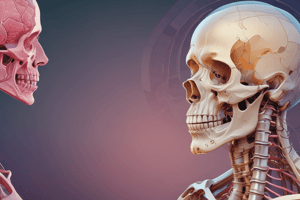Podcast
Questions and Answers
What is the role of diagnostic imaging in modern medical practice?
What is the role of diagnostic imaging in modern medical practice?
It is used to diagnose and treat many medical conditions such as orthopedic, vascular, pulmonary, gastrointestinal, obstetric, urologic, and neurologic conditions.
Which of the following are common imaging modalities? (Select all that apply)
Which of the following are common imaging modalities? (Select all that apply)
- X-ray (correct)
- Magnetic Resonance Imaging (MRI) (correct)
- Electrocardiogram (ECG)
- Nuclear Medicine Imaging (correct)
What are the five basic densities in diagnostic imaging?
What are the five basic densities in diagnostic imaging?
Air, Fat, Soft Tissue or Fluid, Calcium, Metal.
What appears as the blackest on X-ray, CT, or ultrasound?
What appears as the blackest on X-ray, CT, or ultrasound?
What are the characteristics of fat in diagnostic imaging?
What are the characteristics of fat in diagnostic imaging?
What appears as the whitest on imaging?
What appears as the whitest on imaging?
What is the main benefit of using MRI?
What is the main benefit of using MRI?
What is the significance of orientation in diagnostic imaging?
What is the significance of orientation in diagnostic imaging?
What does 'AP' stand for in radiographic terms?
What does 'AP' stand for in radiographic terms?
Ultrasound imaging is expensive compared to other imaging modalities.
Ultrasound imaging is expensive compared to other imaging modalities.
What is a major risk associated with CT imaging?
What is a major risk associated with CT imaging?
Flashcards are hidden until you start studying
Study Notes
Role of Diagnostic Imaging in Modern Medical Practice
- Essential tool for diagnosing and treating numerous medical conditions across specialties such as orthopedics, vascular, pulmonary, gastrointestinal, obstetric, urologic, and neurology.
- Therapeutic radiation is widely utilized, especially in oncology.
- Interventional radiology employs real-time imaging for diagnostic and therapeutic procedures.
Common Imaging Modalities
- Ionizing Radiography: Includes X-rays, fluoroscopy, and CT scans; employs ionizing radiation to create images on digital plates.
- Magnetic Resonance Imaging (MRI): Utilizes strong magnetic fields and radio frequencies to generate 2D and 3D images; particularly effective in neuroscience and orthopedics.
- Nuclear Medicine: Involves the use of radioactive isotopes to monitor decay rates for imaging; used for specialized scans such as SPECT, PET, and thyroid scans.
- Ultrasonography: Uses acoustic energy to create images by measuring ultrasound wave reflections; becomes brighter with higher density structures.
Basic Densities in Diagnostic Imaging
- Air: Appears black on X-ray, CT, and ultrasound.
- Fat: Displays a lighter shade of gray.
- Soft Tissue or Fluid: Density affects appearance; denser fluid appears gray, while less dense fluid looks black.
- Calcium: Primarily found in bones, but may appear in other structures.
- Metal: Appears whitest; typically represents foreign objects or contrast agents.
Orientation to Images
- Understanding orientation is critical; identify what is up and down in images.
Radiographic Language and Exam Ordering
- Key terms include AP (anteroposterior), LAT (lateral), CT without/with contrast (highlights different structures), MRI without/with contrast.
- Order only necessary images to confirm or exclude hypotheses; consider radiation exposure, costs, and examination duration.
Common Clinical Uses of Imaging Modalities
- X-Ray: Useful for fractures, pneumonia, and foreign body localization; risk of radiation exposure.
- CT: Effective for organ function and vascular exams; provides better diagnostic accuracy but poses risks of radiation and contrast allergies.
- MRI: Ideal for soft tissue examinations with no radiation; offers the greatest diagnostic accuracy but is expensive and time-consuming.
- Ultrasound: Non-invasive and useful for superficial structures; dependability increases with skilled sonographers.
- Nuclear Medicine: Important for functional imaging and specific disease diagnoses; however, requires special equipment and may be slow.
Comparison of Imaging Modalities
- X-Ray: Fast and inexpensive, good image quality, but limited in internal organ assessments.
- CT: Gold standard for many diagnoses, good imaging quality, but with radiation risks.
- MRI: Highest diagnostic accuracy with no radiation; long duration and higher costs may limit use.
- Ultrasound: Safe, quick, and bedside examinations; image quality heavily relies on the operator’s skill.
- Nuclear Medicine: Functional imaging provides specific diagnostic details, but is costly and requires slow processes.
Safety Limitations of Imaging Modalities
- Each imaging modality carries its own safety concerns, especially related to radiation exposure and contrast material allergies, warranting careful consideration in clinical decisions.
Studying That Suits You
Use AI to generate personalized quizzes and flashcards to suit your learning preferences.




